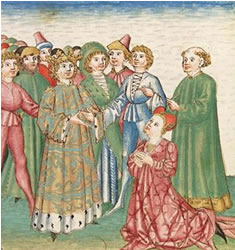German Adaptations of French Chansons de Geste
Medieval Women Writers as Agents of Cultural Exchange: The Case of Elisabeth Von Nassau-Saarbücken (Christine McWebb, University of Waterloo)
The study of female writers in the context of cultural exchange in the European Middle Ages and Early Modern period remains quasi-unexplored territory despite the now well-established concept of cultural exchange or cultural transfer in the humanities and the social sciences. It is for this reason that the German writer Elisabeth of Nassau-Saarbrücken’s works
require critical attention and need to be made available to the English-speaking scholar and student.
Between 1430 and 1437 the French-German female writer Elisabeth von Nassau-Saarbrücken (1393 or 1397?-1456) translated into German and rewrote a cycle of four French chansons de geste. In chronological order they are Herpin which is an adaptation of the chanson de geste Lion de Bourges , then Der Roman von der Königin Sibille[The Romance of the Queen Sibille] from the French La reine Sébile or
, then Der Roman von der Königin Sibille[The Romance of the Queen Sibille] from the French La reine Sébile or
its closely related version Macaire. This work is followed by Loher und Maller[Loher and Maller]. The adaptation of the famous chanson de geste about the legendary first Capetian king Hugues Capet which bears the titleHuge Scheppel in German concludes the cycle. All four
works were popular from the very moment of their appearance, responding to the literary taste of the nobility for the most modern literature coming out of France at that time. This is attested by the numerous extant print versions today.
Von Nassau-Saarbrücken is frequently referred to as one of the first German female authors writing secular texts in the vernacular. She is considered a literary novelty since she introduced the new genre of the prose novel into German literature during the first half of the fifteenth century.
The first chanson de geste Lion de Bourges is now available.


